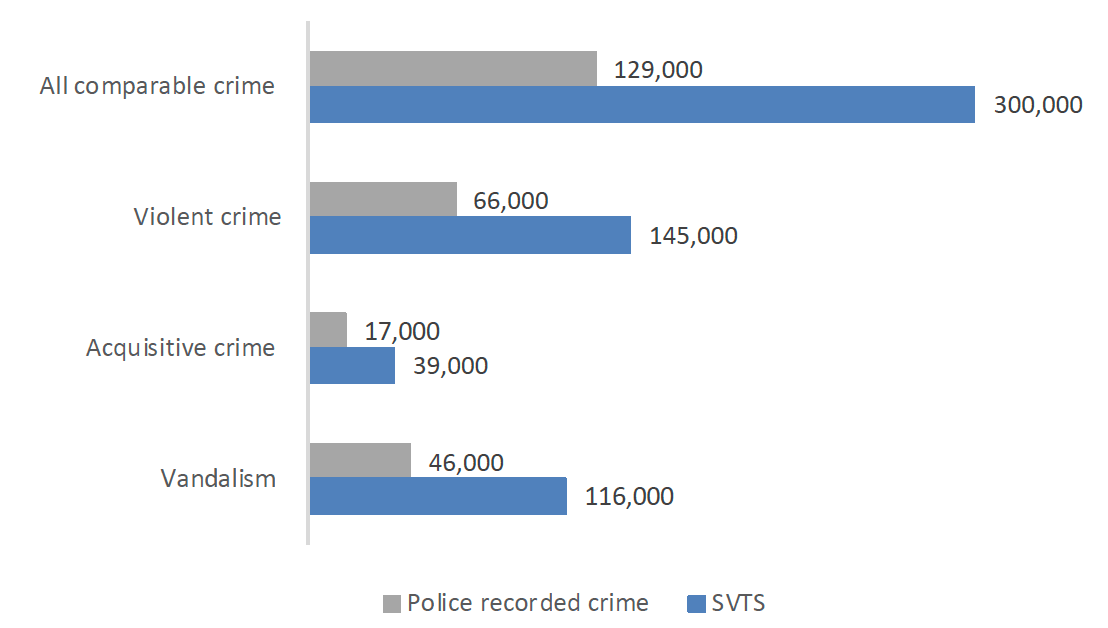Scottish Victimisation Telephone Survey 2020: main findings
Main findings from the Scottish Victimisation Telephone Survey 2020.
3. Bringing together crime statistics
This chapter includes:
- An overview of the different sources of crime statistics available in Scotland
- Comparisons of SVTS crime and police recorded crime
3.1 Sources of crime statistics for Scotland
The main sources of crime statistics for Scotland are police recorded crime and nationally representative crime surveys – the Scottish Victimisation Telephone Survey (SVTS) and the Scottish Crime and Justice Survey (SCJS).
Police recorded crime and crime surveys are essential, complementary evidence sources that, when considered together, present a fuller picture of crime in Scotland.
Police recorded crime captures a broad range of crimes that are recorded by the police and is particularly useful for lower-volume crimes that can be difficult for sample surveys of the population to capture. However, this data is sensitive to changes in recording practices and police activity and cannot include information about crimes that are not reported to or recorded by the police.
Crime surveys are able to collate a wider assessment of the overall level of crime and likelihood of experiencing crime, including crimes which do not come to the attention of the police. They can also provide additional contextual information such as the characteristics of crime, the way in which crime affects different cohorts of the population, and on repeat victimisation. However, crime surveys are less able to gather information on rarer forms of crime or crimes where there is no specific victim to interview (for example, homicide).
Both the SVTS and police recorded crime provide data on crime during the COVID-19 pandemic, up to September 2020, which allows for comparisons to be made with crime in Scotland before and after the start of the UK's first national lockdown. The SCJS provides evidence on the longer-term trends of crime in Scotland, including incidents not reported to the police, from 2008 up to the suspension of all face-to-face interviews on 17th March 2020. Annex B provides more information on the strengths and limitations of police recorded crime, the SVTS, and the SCJS.
3.2 SVTS comparable crime and police recorded crime
Of the 445,000 crimes estimated by the SVTS, a little over two-thirds can be compared with police recorded crime.
The information below is provided based on an analysis of a sub-set of comparable crimes, which includes three broadly comparable sub-groups: violent crime, acquisitive crime, and vandalism[18].
Of the 445,000 crimes estimated by the SVTS, a little over two-thirds (68%, 300,000) can be compared with police recorded crimes. During the period between September 1st 2019 and September 30th 2020[19], the police recorded 129,000 crimes and offences in the comparable sub-set[20], representing approximately 43% of the number of crimes in the SVTS comparable sub-set.
It is to be expected that the crime estimates produced by the SVTS are higher than police recorded crime figures, even in the comparable sub-set, because the survey was able to capture crime which did not come to the attention of the police[21].
Within the comparable sub-set the types of crimes can be categorised into violent crime, acquisitive crime, and vandalism. Violent comparable crime includes serious assault, minor assault and robbery. The SVTS estimated a total of 145,000 comparable violent crimes, whereas there were 66,000 comparable police recorded violent crimes, representing approximately 45% of the SVTS estimated comparable violent crimes.
Acquisitive comparable crime includes bicycle theft, housebreaking and theft of a motor vehicle. The SVTS recorded a total of 39,000 comparable acquisitive crimes, whilst there were 17,000 comparable police recorded acquisitive crimes, representing approximately 43% of the SVTS estimated comparable acquisitive crimes.
Finally, vandalism includes motor vehicle vandalism and property vandalism. The SVTS estimates a total of 116,000 comparable vandalism crimes, whereas there were 46,000 comparable police recorded vandalism crimes, representing approximately 40% of the SVTS estimated comparable vandalism crimes.

Sources: SVTS 2020 (2,654), Police recorded crime. Variables: INCCOMPARCRIME, INCVIOLENT, INCACQUIS, INCVAND.
By considering police recorded crime data by quarter, it is possible to assess any change in the volume of recorded crime between October 2019 to March 2020 and April 2020 to September 2020. This can be used as a broad assessment of changes before and after the UK's first national lockdown on 23rd March 2020.
From October 2019 through to March 2020 there were approximately 61,000 comparable police recorded crimes, whilst from April 2020 through to September 2020 there were 58,000 comparable police recorded crimes. This equated to an approximate fall of 5% in comparable police recorded crime. The fall in crime was mostly concentrated in the period between April 2020 and June 2020.
Looking back over 2013/14 to 2019/20, comparable recorded crime has been higher in April to September compared to the October to March period of the previous financial year. The fall in comparable recorded crime between October 2019 to March 2020 and April to September 2020 is therefore a notable difference to this trend, with a potential factor being the impact of COVID-19 and restrictions put in place to limit the spread of the virus.
Whereas comparable police recorded crime fell by 5% after the UK's first national lockdown, the SVTS found no significant difference in the number of comparable crimes experienced by adults over a similar period. This suggests that any changes that may have occurred in comparable crime across Scotland during this period, were insufficient to be identified by the SVTS.
Contact
Email: scjs@gov.scot
There is a problem
Thanks for your feedback